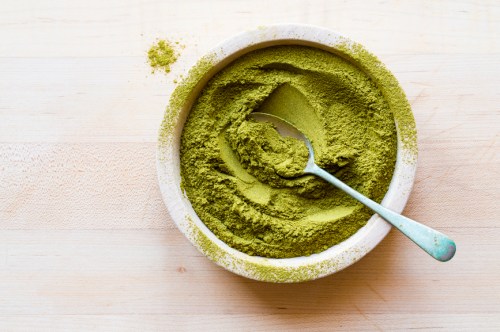Before You Stock up on Supergreen Powders, Know That They Lack One Nutrient That’s Hugely Important for Gut and Heart Health
While supergreen powders have become increasingly popular for their health benefits, this dietitian says they often lack fiber.

When it’s time to decide what to eat or drink, certain criteria—such as taste, nutritional content, convenience, and so on—tend to run through your mind on autopilot. With that said, if you want to boost your vitamin and mineral intake but are short on time or lack the appetite for a bulky bowl of leafy green goodness or hearty vegetable soup (I get it, not everyone loves a mountain of kale or stewed carrots as much as I do), supergreen powders and tablets can seem like a promising, effort-free way to squeeze more nutrients into your diet.
Experts in This Article
registered dietitian and co-owner of A Taste of Health, LLC
All good—but before you pile these (oftentimes pricey) concentrated dietary supplements to your cart, you should know that there’s one key nutrient they fall short on compared to their whole-food counterparts. Hint: It’s one of the GOATs for digestion but also heart health, longevity, skin, inflammation, and more. Indeed, it can only be… fiber.
The health benefits of supergreen powders
Again, not everyone has the time to head to the market, scour the produce aisle, cut and clean pounds of produce, and prep them to eat raw or to cook, blend, or juice. For that reason, supergreen powders are a highly convenient, one-and-done solution to get more greens in as quickly as you can say scoop, stir, and swallow.
Moreover, such concentrated solutions offer a foolproof way to boost your intake of some very important micronutrients on a consistent basis—particularly if you wouldn’t be getting them otherwise. “These powders can provide many of the vitamins and minerals generally obtained from vegetables,” starts Ricci-Lee Hotz, MS, RDN, a nutrition expert at Testing.com. “For individuals who struggle to consume enough vegetables each day, a purity-tested product can allow for consuming enough micronutrients.”
And while certain supergreen powders boast up to dozens of these vitamins and minerals, they’re generally low in fiber—if they contain any at all.
Why supergreen powders aren’t a good source of fiber
There are countless reasons why dietitians and other health experts always suggest getting the majority of your nutrient intake from fresh, whole foods. And when it comes to supergreens (as well as other fruits and veggies) in particular, considerations specific to fiber rank near the top of the list.
“Supergreen powders are typically low in fiber, as the [process of] nutrient extraction breaks down or removes the fiber element that you would normally receive from natural vegetable sources,” Hotz says. Although vitamins and minerals are retained in the extraction process and ultimately live a second life in powder or tablet form, the same can’t be said about fiber. (Unfortunately, the same fate for fiber applies to your favorite cold-pressed and centrifugal green juices, though smoothies can offer higher amounts if the final blend contains the fibrous pulp and/or skin of a given fruit or veggie.)
“For this reason, while supergreen powders do have their merits, I would not say they are the best option if an individual is looking for help with digestion or gut health,” Hotz says.
The health benefits of fiber intake
While fiber may not have a reputation of being among the most “sexy” nutrients in the wellness world (blame it in part on the thick, less-than-tasty fiber supplements of yesteryear and a now outdated reluctance to wax poetic on the beauty of healthy bowel movements), its benefits can’t be underestimated.
To start, fiber is a proven hero when it comes to supporting digestion and greater gut health. “Fiber fuels our healthy gut bacteria, bulks up stool to minimize diarrhea, and helps slow down digestion enough to aid in further absorption,” Hotz says. “It also helps bind ‘bad cholesterol’ and remove it from our systems, and lower amounts of LDL cholesterol are associated with a lower risk of cardiovascular disease.”
Moreover, greater fiber intake is linked to a range of additional health benefits well beyond gut and heart health. In fact, one study published in The Journals of Gerontology in October 2016 found that amongst 1,600 healthy adults over the age of 49, those who consumed fiber-rich diets over the course of a decade had greater odds of aging successfully compared to groups that consumed less fiber. The markers of successful aging included “the absence of disability, depressive symptoms, cognitive impairment, respiratory symptoms, and chronic diseases,” including cancer. In other words, you’ll absolutely want to make sure you get enough fiber in your diet if you want to boost your odds of gaining a clean bill of health in the years to come.
How much fiber you need (and where to find it)
According to a 2021 report by the American Society for Nutrition (ASN)—which aggregated data from nearly 15,000 participants over the course of five years—only seven percent of adults in the United States meet their daily recommended intake for fiber… which clocks in around where, exactly?
“Women should aim for about 21 to 25 grams of fiber per day, while men should aim for 30 to 38 grams per day,” Hotz says. However, the recommended intake varies a bit across different sources—for instance, the ASN cites 14 grams of fiber for every 1,000 calories consumed as another general guideline to keep in mind. At any rate, it’s clear that the majority of us would be wise to take special care to bulk up our diets—and stools—with this overachieving, under-consumed nutrient. (Just note that you’ll want to slowly increase your intake in order to avoid causing or exacerbating GI distress, and drink plenty of water in the process to *move things along.* Also, if you currently suffer from chronic digestive issues, consult a trusted health professional to find the best dietary plan specific to your concerns.)
In sum, supergreen powders can potentially benefit your diet and lifestyle in some ways, but they lack the fiber necessary to help you yield a wider range of benefits—digestive and otherwise. For this reason, take care to add more fibrous, plant-based foods into your rotation in tandem with consuming these supplements. “Some of the best sources of fiber include fruits and vegetables [in their whole forms], whole grains, nuts, and seeds,” Hotz shares. Need more inspo? She continues to say that you can get creative with boosting your fiber intake by “baking a bulked up overnight oat dish, making your own grain bowls, or adding seeds (e.g., chia or flax) into a smoothie.”










